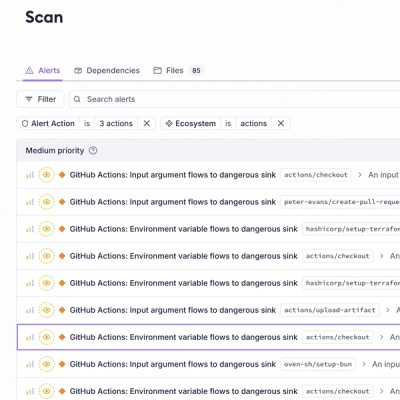
Product
Introducing Socket Firewall Enterprise: Flexible, Configurable Protection for Modern Package Ecosystems
Socket Firewall Enterprise is now available with flexible deployment, configurable policies, and expanded language support.
github.com/steveteuber/kubectl-graph
Advanced tools
A kubectl plugin to visualize Kubernetes resources and relationships.
This plugin requires Graphviz, Neo4j or ArangoDB to visualize the dependency graph.
The default output format requires dot to convert the output into a useful format.
brew install graphviz
The CQL output format requires cypher-shell to connect to a Neo4j database.
brew install cypher-shell
The AQL output format requires curl and jq to send API requests to an ArangoDB server.
brew install curl jq
Do you miss something? Please open an issue or create a pull request.
This kubectl plugin is distributed via krew. To install it, run the following command:
kubectl krew install graph
In general, this plugin is working like kubectl get but it tries to resolve relationships between the Kubernetes
resources before it prints a graph in AQL, CQL or DOT format. By default, the plugin will use DOT as output format.
kubectl graph [(-o|--output=)aql|arangodb|cql|cypher|dot|graphviz|mermaid] (TYPE[.VERSION][.GROUP] ...) [flags]
This quickstart guide uses macOS. It's possible that the commands can differ on other operating systems.

When you have installed the dot command line tool, then you can start to fetch all running Pods in the
kube-system namespace and pipe the output directly to the dot command.
kubectl graph pods --field-selector status.phase=Running -n kube-system | dot -T svg -o pods.svg
Now you will have a pods.svg file in the current working directory, which can be viewed with any web browser:
open pods.svg
If you're not happy with SVG as output format, please take a look at the offical documentation.


Before you can import all your Kubernetes resources, you will need to create a Neo4j database.
This can be done in multiple ways and is based on your preference.
Docker is the easiest way to get started with a Neo4j server and an empty database.
docker run --rm -p 7474:7474 -p 7687:7687 -e NEO4J_AUTH=neo4j/secret neo4j
When the container is up and running then you can open the Neo4j Browser interface at http://localhost:7474/.
The Neo4j Desktop application lets you easily create any number of local databases.
brew install --cask neo4j
After installation, open the Neo4j Desktop.app and do the following steps:
quickstart and password secret.
When you have opened the Neo4j Browser interface, then you can start to fetch all resources in the
kube-system namespace and pipe the output directly to the cypher-shell command.
kubectl graph all -n kube-system -o cypher | cypher-shell -u neo4j -p secret
Finally, within the Neo4j Browser interface you can enter the following queries in the command line:
MATCH (n) RETURN n // Render all nodes as a visual graph
MATCH (n) DETACH DELETE n // Delete all nodes and relationships
For more information about the Cypher query language, please take a look at the offical documentation.


Before you can import all your Kubernetes resources, you will need to create an ArangoDB database.
This can be done in multiple ways and is based on your preference.
Docker is the easiest way to get started with an ArangoDB server and an empty database.
docker run --rm -p 8529:8529 -e ARANGO_NO_AUTH=1 arangodb
When the container is up and running then you can open the ArangoDB Browser interface at http://localhost:8529/.
If you start with an empty database you need to create two collections one for resources and one for relationships.
curl http://localhost:8529/_api/collection -d '{"type": 2, "name": "resources"}'
curl http://localhost:8529/_api/collection -d '{"type": 3, "name": "relationships"}'
After that you also need to create a graph which requires the name and a definition of its edges.
curl http://localhost:8529/_api/gharial -d @- <<EOF
{"name": "quickstart", "edgeDefinitions": [
{"collection": "relationships", "from": ["resources"], "to": ["resources"]}
]}
EOF
Finally, when you created the two collections then you can start to fetch all resources in the
kube-system namespace and pipe the output directly to the ArangoDB HTTP API endpoint.
kubectl graph all -n kube-system -o aql \
| eval 'jq -n --arg stdin "$(cat)" "{query:\$stdin}"' \
| curl http://localhost:8529/_api/cursor -d @-
For more information about the HTTP API, please take a look at the offical documentation.
Loki is a horizontally-scalable, highly-available, multi-tenant log aggregation system inspired by Prometheus.

kubectl graph all -n loki -o cypher | cypher-shell -u neo4j -p secret
If you wish to work on the plugin, you'll first need Go installed on your machine and then you can simply run the following command to test your changes:
go run ./cmd/kubectl-graph/main.go all -n <namespace> | dot -T png -o all.png
This project is licensed under the Apache License 2.0, see LICENSE for more information.
FAQs
Unknown package
Did you know?

Socket for GitHub automatically highlights issues in each pull request and monitors the health of all your open source dependencies. Discover the contents of your packages and block harmful activity before you install or update your dependencies.

Product
Socket Firewall Enterprise is now available with flexible deployment, configurable policies, and expanded language support.

Security News
Open source dashboard CNAPulse tracks CVE Numbering Authorities’ publishing activity, highlighting trends and transparency across the CVE ecosystem.

Product
Detect malware, unsafe data flows, and license issues in GitHub Actions with Socket’s new workflow scanning support.